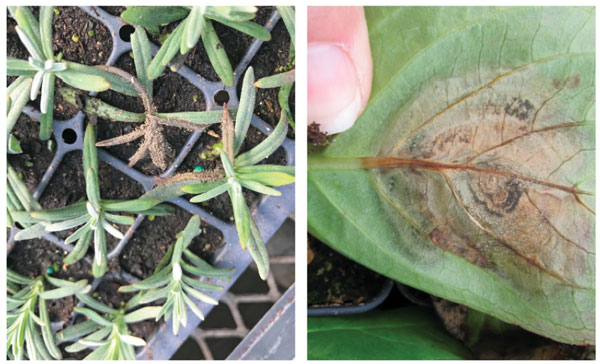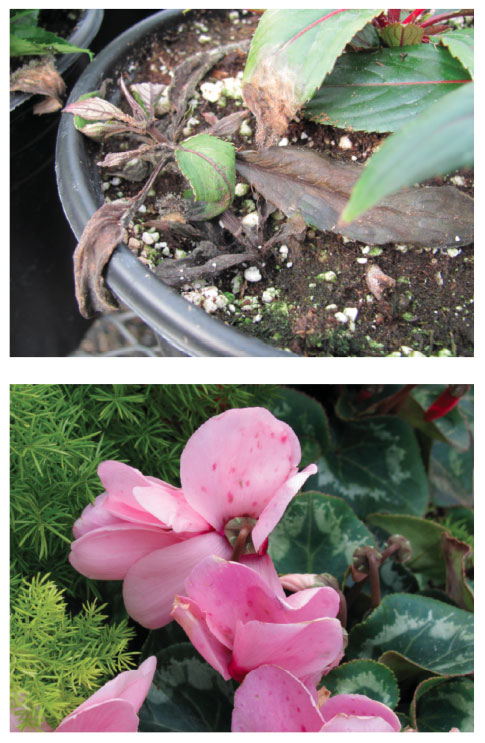11/1/2021
Botrytis Season Doesn’t End When the Poinsettias Ship
A.R. Chase & Aaron J. Palmateer

Now is the time to consider doing more to prevent Botrytis blight—in fact, it may be a little late depending on where your operation is in the U.S. Botrytis is favored by typical winter conditions, which include cold temperatures, lower light and lower growth rates. The overall result of these winter conditions is wet foliage for a longer period of time.
Botrytis blight is usually caused by Botrytis cinerea, but other species are found on some bulb crops like tulip, lily and hyacinth. Botrytis cinerea has a VERY wide host range affecting nearly all ornamental (and many other) crops. Botrytis is sometimes an opportunistic pathogen and attacks plants in propagation, crowded conditions and those in flower.
 Botrytis cinerea causes flower spots, stem rot, leaf spots and blight, cutting rot and damping-off, so disease can occur during all stages of crop production. Be sure to check inside plant canopies, whether they’re in propagation or production. This is the ideal area for Botrytis to start and spread undetected. Hanging baskets often drop petals on bench-grown crops directly below. Botrytis gains a foothold in the fallen petals and then progresses into the leaves and crowns of the bench crop. Botrytis sporulation always appears the same, so if you see something very white, brown or purplish, you’re not looking at Botrytis. Spores can be described as grayish or brownish in color.
Botrytis cinerea causes flower spots, stem rot, leaf spots and blight, cutting rot and damping-off, so disease can occur during all stages of crop production. Be sure to check inside plant canopies, whether they’re in propagation or production. This is the ideal area for Botrytis to start and spread undetected. Hanging baskets often drop petals on bench-grown crops directly below. Botrytis gains a foothold in the fallen petals and then progresses into the leaves and crowns of the bench crop. Botrytis sporulation always appears the same, so if you see something very white, brown or purplish, you’re not looking at Botrytis. Spores can be described as grayish or brownish in color.
Pictured far left: Botrytis blight on rosemary cuttings.
Left: Botrytis sporulation on the underside of a hydrangea leaf.
High humidity and more than six hours of leaf wetness are most important for an outbreak of Botrytis. Temperatures around 50 to 75F (10 to 24C) are ideal and poor air circulation promotes most foliar diseases since it means leaves will stay wet longer and relative humidity around the plant is higher. Losses due to Botrytis reach far beyond production where the disease is common on plants and plant products during shipping. It is also frequently an issue for post-harvest storage, even in coolers for cold storage. Damage to the crop (phytotoxicity and wounding) can promote a Botrytis outbreak.
Nearly all plants can be attacked by this very general fungal pathogen. Those in propagation are especially sensitive since the excess water required for rooting will also promote Botrytis blight. Plants that normally thrive in warm to hot weather are especially vulnerable since they’re physiologically stressed, and weak plants are more susceptible to Botrytis. Diseased plants and plant tissue serve as a source of inoculum that can quickly spread, so it’s important to remove and discard dead blooms, leaves and other plant debris on or under greenhouse benches and in plant beds.
 There are quite a few choices that can be very effective in preventing, and in some cases curing, Botrytis blight. One of the active ingredients with the longest use for Botrytis is chlorothalonil (found in Daconil formulations and Spectro 90). Residue may be a concern in some crops and especially when they’re near finishing. (Remember that chlorothalonil can damage petals and its use should be timed before flowering starts.) Flowers damaged by chlorothalonil look a lot like Botrytis damage and can lead to the erroneous conclusion that there’s resistance to the product.
There are quite a few choices that can be very effective in preventing, and in some cases curing, Botrytis blight. One of the active ingredients with the longest use for Botrytis is chlorothalonil (found in Daconil formulations and Spectro 90). Residue may be a concern in some crops and especially when they’re near finishing. (Remember that chlorothalonil can damage petals and its use should be timed before flowering starts.) Flowers damaged by chlorothalonil look a lot like Botrytis damage and can lead to the erroneous conclusion that there’s resistance to the product.
Pictured: Botrytis cutting rot on New Guinea impatiens..
Fenhexamid (Decree) is another fungicide that provides excellent control. Decree is the only fungicide in FRAC 17, which makes it an excellent rotation partner for many other fungicides that provide a very high degree of Botrytis control. This product has a narrow range of activity (mainly Botrytis), but has been the most effective at killing spores if disease starts. The first year we did research on the numbered compound, almost all the researchers across the U.S. reported on this unique ability to wipe out spores. It’s been an industry standard for Botrytis control since it was first registered in the late 1990s. At one point, resistance was reported in a limited way, so be sure to rotate Decree with fungicides from other FRAC groups.
Pictured: Botrytis petal spots on cyclamen.
Fludioxinil is another active ingredient for use against Botrytis. It can be found in Medallion and Palladium, which also has cyprodinil. Both active ingredients in Palladium offer Botrytis control, so its use can be considered a good strategy for resistance management. There are a few crops that shouldn’t be treated with fludioxinil (refer to the product label).
Iprodione (Chipco formulations like 26GT and 26019) have also been available for the past 30 years or so. It has a broad-spectrum of activity and can be used as a spray or drench.
Finally, since around 2008, when the first FRAC 7/11 combination, Pageant Intrinsic (pyraclostrobin and boscalid), was registered, we’ve seen three others follow: Broadform (trifloxystrobin and fluopyram), Mural (azoxystrobin and solatenol) and Orkestra Intrinsic (pyraclostrobin and fluxapyroxad), which are also effective on Botrytis. Of these 7/11 premixes, the best candidates in Ann Chase’s trials in the past five years have been Broadform and Orkestra Intrinsic.
Fungicides are one of the most important tools for disease management and it’s critical that individuals making fungicide application decisions follow the manufacturer’s label for proper rates and intervals. The preventative use of fungicides and recognizing the importance of rotating FRAC groups for control of common and aggressive plant diseases such as Botrytis blight will ensure long-term success and future availability of fungicides for effective disease management.
As the title implies, Botrytis season doesn’t end when the poinsettias ship, so get out there and look closely for early signs of Botrytis blight—look under the leaves. Don’t let plants go to bed wet since this easily exceeds the six-hour leaf wetness minimum needed for spores to germinate. Don’t use a copper fungicide when it won’t dry quickly since phytotoxicity can be an issue and end up starting a Botrytis outbreak.
Finally, be sure to rotate modes of action since Botrytis populations have proven resistant to some fungicides, but mainly when they’re used at lower-than-labeled rates, week after week after week. GT
A.R. Chase is a consultant with Chase Agricultural Consulting, LLC. She can be reached at archase@chaseresearch.net. Aaron J. Palmateer
is Technical Development Manager for SePRO Corporation. He can be reached at aaronp@sepro.com.